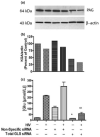Glutamate production by HIV-1 infected human macrophage is blocked by the inhibition of glutaminase
- PMID: 17596215
- PMCID: PMC1976281
- DOI: 10.1111/j.1471-4159.2007.04594.x
Glutamate production by HIV-1 infected human macrophage is blocked by the inhibition of glutaminase
Abstract
Mononuclear phagocyte (macrophages and microglia) dysfunction plays a significant role in the pathogenesis of human immunodeficiency virus (HIV) associated dementia (HAD) through the production and release of soluble neurotoxic factors including glutamate. The mechanism of glutamate regulation by HIV-1 infection remains unclear. In this report, we investigated whether the enzyme glutaminase is responsible for glutamate generation by HIV-1 infected monocyte-derived macrophages. We tested the functionality of novel small molecule inhibitors designed to specifically block the activity of glutaminase. Glutaminase inhibitors were first characterized in a kinetic assay with crude glutaminase from rat brain revealing an uncompetitive mechanism of inhibition. The inhibitors were then tested in vitro for their ability to prevent glutamate generation by HIV-infected macrophages, their effect upon macrophage viability, and HIV infection. To validate these findings, glutaminase specific siRNA was tested for its ability to prevent glutamate increase during infection. Our results show that both glutaminase specific small molecule inhibitors and glutaminase specific siRNA were effective at preventing increases in glutamate by HIV-1 infected macrophage. These findings support glutaminase as a potential component of the HAD pathogenic process and identify a possible therapeutic avenue for the treatment of neuroinflammatory states such as HAD.
Figures










References
-
- Belmadani A, Zou J, Schipma MJ, Neafsey EJ, Collins MA. Ethanol pre-exposure suppresses HIV-1 glycoprotein 120-induced neuronal degeneration by abrogating endogenous glutamate/Ca2+-mediated neurotoxicity. Neuroscience. 2001;104:769–781. - PubMed
-
- Chen HS, Lipton SA. The chemical biology of clinically tolerated NMDA receptor antagonists. J. Neurochem. 2006;97:1611–1626. - PubMed
-
- Choi DW. Glutamate neurotoxicity and diseases of the nervous system. Neuron. 1988;1:623–634. - PubMed
-
- Curthoys NP, Watford M. Regulation of glutaminase activity and glutamine metabolism. Annu. Rev. Nutr. 1995;15:133–159. - PubMed
Publication types
MeSH terms
Substances
Grants and funding
LinkOut - more resources
Full Text Sources
Other Literature Sources

